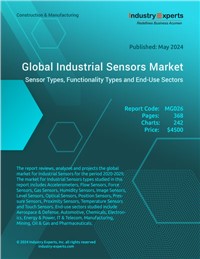A shift towards the concept of Industry 4.0 and wider automation protocols has propelled the use of sensors in various manufacturing operations, as these devices enable in maximizing efficiency of operations and also increasing production uptime. With growth in demand for industrial automation, a subsequent rise in sensor deployment across various stages of manufacturing and product control has become vital.
North America, Europe and Asia-Pacific account for nearly 80% of the global market for Industrial Sensors based on type and functionality. Among these, Asia-Pacific is likely to emerge as the fastest growing market, with an expected CAGR of over 12% during the analysis period. This can be attributed to increasing technological advancements and rapid industrialization, plus to fact that the region has for long been the hub of electronics manufacturing, and the use of sensors in this area is widespread.
Research Findings & Coverage
- Global market for Industrial Sensors is analyzed in this report with respect to sensor types, functionality types, end-use industries, major geographic regions and key countries
- The market share analysis covered for Industrial Sensors based on the segmentation mentioned above; current market size estimation, revenue projections for the analysis period provided through 2029
- The report includes an extensive analysis of the market for more than 10 sensor types and 10 end-use industries with market share illustrations at regular intervals along the study period
- The study discusses major growth trends, R&D, technology updates and emerging applications of Industrial Sensors that influence the market growth
- Key business trends focusing on product innovations/developments, capacity expansions, M&As, JVs and other recent industry developments by the major players
- The report includes 242 data tables covering market numbers by segment and regions with graphical representation for each table
- Brief business profiles of major companies covered – 34
- The industry guide includes the contact details for 321 companies
Product Outline
The market for types of Industrial Sensors analyzed in this report including:
- Accelerometers
- Flow Sensors
- Force Sensors
- Gas Sensors
- Humidity Sensors
- Image Sensors
- Level Sensors
- Optical Sensors
- Position Sensors
- Pressure Sensors
- Proximity Sensors
- Temperature Sensors
- Touch Sensors
Functionality types of Industrial Sensors market analyzed in this report consist the following:
- Contact Sensors
- Contactless Sensors
The report analyzes the market for end-use industries of Industrial Sensors comprises:
- Aerospace & Defense
- Automotive
- Chemical
- Electronics
- Energy & Power
- IT & Telecom
- Manufacturing
- Mining
- Oil & Gas
- Pharmaceutical
Analysis Period, Units and Growth Rates
- The report reviews, analyzes and projects the global Engineering Plastics market for the period 2020-2029 in terms of value in US$ and the compound annual growth rates (CAGRs) projected from 2023 through 2029
Geographic Coverage
- North America (The United States, Canada and Mexico)
- Europe (France, Germany, Italy, Russia, Spain, United Kingdom and Rest of Europe)
- Asia-Pacific (China, India, Japan, South Korea and Rest of Asia-Pacific)
- South America (Argentina, Brazil and Rest of South America)
- Middle East & African



